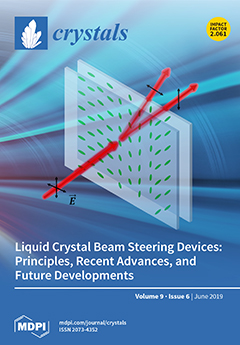We combine theoretical and experimental tools to study elastic properties of Fe-Al-Ti superalloys. Focusing on samples with chemical composition Fe
71Al
22Ti
7, we use transmission electron microscopy (TEM) to detect their two-phase superalloy nano-structure (consisting of cuboids embedded into
[...] Read more.
We combine theoretical and experimental tools to study elastic properties of Fe-Al-Ti superalloys. Focusing on samples with chemical composition Fe
71Al
22Ti
7, we use transmission electron microscopy (TEM) to detect their two-phase superalloy nano-structure (consisting of cuboids embedded into a matrix). The chemical composition of both phases, Fe
66.2Al
23.3Ti
10.5 for cuboids and Fe
81Al
19 (with about 1% or less of Ti) for the matrix, was determined from an Energy-Dispersive X-ray Spectroscopy (EDS) analysis. The phase of cuboids is found to be a rather strongly off-stoichiometric (Fe-rich and Ti-poor) variant of Heusler Fe
2TiAl intermetallic compound with the L2
1 structure. The phase of the matrix is a solid solution of Al atoms in a ferromagnetic body-centered cubic (bcc) Fe. Quantum-mechanical calculations were employed to obtain an insight into elastic properties of the two phases. Three distributions of chemical species were simulated for the phase of cuboids (A2, B2 and L2
1) in order to determine a sublattice preference of the excess Fe atoms. The lowest formation energy was obtained when the excess Fe atoms form a solid solution with the Ti atoms at the Ti-sublattice within the Heusler L2
1 phase (L2
1 variant). Similarly, three configurations of Al atoms in the phase of the matrix with different level of order (A2, B2 and D0
3) were simulated. The computed formation energy is the lowest when all the 1st and 2nd nearest-neighbor Al-Al pairs are eliminated (the D0
3 variant). Next, the elastic tensors of all phases were calculated. The maximum Young’s modulus is found to increase with increasing chemical order. Further we simulated an anti-phase boundary (APB) in the L2
1 phase of cuboids and observed an elastic softening (as another effect of the APB, we also predict a significant increase of the total magnetic moment by 140% when compared with the APB-free material). Finally, to validate these predicted trends, a nano-scale dynamical mechanical analysis (nanoDMA) was used to probe elasticity of phases. Consistent with the prediction, the cuboids were found stiffer.
Full article





